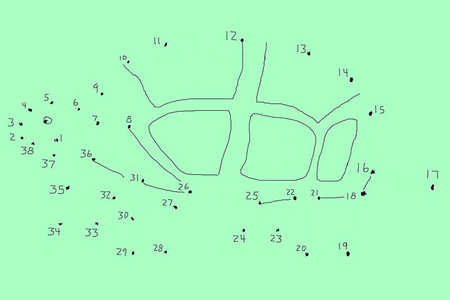
Source: Connect the Dots, jimblodget, Flickr
Have you ever played “Connect the Dots”? One of the best parts is seeing how quickly a recognizable image emerges. In a play, the characters and the stage directions act like the dots. By listening to the dialogue and visualizing the stage directions, we are able to understand the meaning of the play. We’re able to connect the dots!
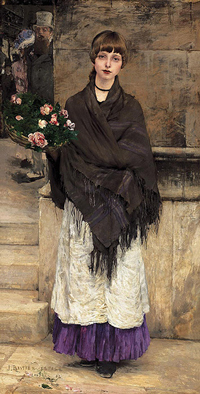
Source: jules bastien-lepage: flower-seller in London, Jules Bastien-Lepage, Flickr
In the scene you will soon read from act 1 of the play My Fair Lady, the character Eliza, a sidewalk flower seller, has come to the home of Professor Higgins, a speech teacher. The two characters met for the first time on the previous night outside the opera house in London, where Eliza asks him to buy a flower. Instead of buying a flower, though, the professor takes down notes about the way Eliza speaks. When Eliza finds out that the professor teaches speech, she decides to pay him a visit at his home. Mrs. Pearce is the professor’s housekeeper, and Pickering is another speech teacher visiting Higgins.
Read the following passage, including the stage directions, which are italicized and sometimes found in parentheses. As you read, look for evidence in the text that indicates the kind of work Higgins does. When you find textual evidence that tells you he is a professor, a teacher of speech and language, click on it. If you choose correctly, the chosen word(s) will highlight. Several examples are already highlighted for you. You should find six additional examples.

For the next exercise, check the box beside the inference you could make from the passage you read. Then, click on “Think Aloud” to see the text evidence (our version of the “dots”) that may have led you to make the inference.

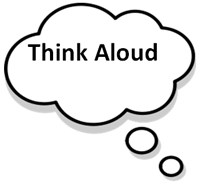
Source: Bulle / bubble, Improulx, OpenClipArt

Source: Bulle / bubble, Improulx, OpenClipArt
As you can see, playwrights use text evidence in both dialogue and stage directions to help us make inferences about setting and characters. Read the next passage, a continuation of the same scene from My Fair Lady. Pay particular attention to the text evidence that helps you make inferences about the characters Eliza and Professor Higgins.
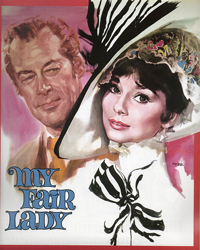
Source: “My Fair Lady” poster, 1964, thefoxling, Flickr
(ELIZA enters . . . She has a hat with three ostrich feathers, orange, sky-blue, and red. She has a nearly clean apron, and the shoddy coat has been tidied a little. . . .)
HIGGINS
( . . . recognizing her with unconcealed disappointment . . . ) Why, this is the girl I jotted down last night. She’s no use; I’ve got all the records I want of [her] lingo . . . (To the girl) Be off with you: I don’t want you.
ELIZA
Don’t be so saucy. You ain’t heard what I come for yet. (To Mrs. Pearce, who is waiting at the door for further instructions) Did you tell him I come in a taxi?
MRS. PEARCE
Nonsense, girl! What do you think a gentleman like Mr. Higgins cares what you came in?
ELIZA
Oh, we are proud! He ain’t above giving lessons, not him: I heard him say so. Well, I ain’t come here to ask for any compliment; and if my money’s not good enough I can go elsewhere.
HIGGINS
Good enough for what?
ELIZA
Good enough for ye-oo. Now you know, don’t you? I’m come to have lessons, I am. And to pay for ’em too: make no mistake.
HIGGINS
(Stunned) Well!!! (Recovering his breath with a gasp) What do you expect me to say to you?
ELIZA
Well, if you was a gentleman, you might ask me to sit down, I think. Don’t I tell you I’m bringing you business?
HIGGINS
Pickering, shall we ask this baggage to sit down, or shall we throw her out of the window?
ELIZA
(Running away in terror) Ah-ah-oh-ow-ow-ow-oo! (Wounded and whimpering) I won’t be called a baggage when I’ve offered to pay like any lady!
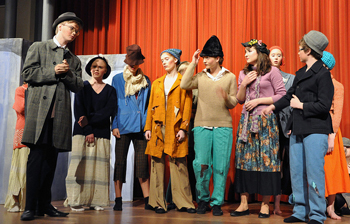
Source: 2011 05 15_0605, Swedish Saguaro, Flickr
 Now, use your notes to answer the following inference questions. Make sure to include text evidence in your answers. When you’re finished with each question, check your understanding to see a possible response or responses.
Now, use your notes to answer the following inference questions. Make sure to include text evidence in your answers. When you’re finished with each question, check your understanding to see a possible response or responses. - What do you think is Eliza’s purpose for dressing as she does for this visit?
- What are three examples of text evidence related to clothing, speech, or actions that show Eliza wants to appear proper or acceptably sophisticated for this visit?
Text Evidence: Eliza wants to appear “like any lady” who can afford to pay for speech lessons.
Text Evidence: 1. Eliza is wearing a fancy hat, a “nearly clean apron,” and a coat she has tidied up. 2. Eliza emphasizes that she has “come in a taxi,” showing that she has enough money to pay for a taxi ride to his home. 3. Eliza tells Higgins she is prepared “to pay like any lady” for speech lessons.
Now, try to make a complex inference from the bits of information that are not as easily connected.
- Why do you think Higgins refers to Eliza as “baggage”?
Text Evidence: 1. Perhaps Higgins still thinks of her as lower in status than he is despite her efforts to appear sophisticated. He is not very caring about her feelings. 2. As shown in the opening stage directions, he is “careless about himself and other people, including their feelings.”
You have already connected many dots to create inferences, including a complex inference. In the next section, you will discover more about using hidden clues to make complex inferences.